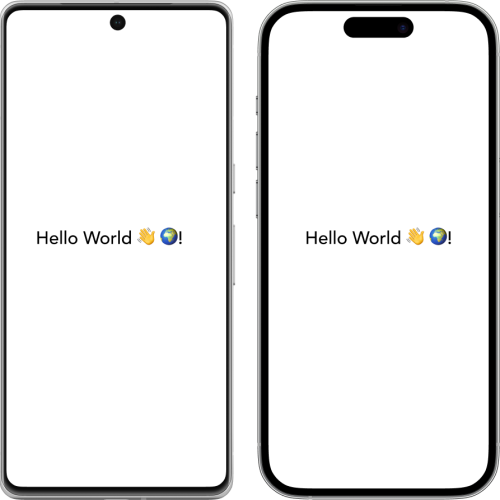Mobile App Types
While discussing mobile app types, we will evaluate application development methods based on need. Mobile applications now play an essential role in our lives. They simplify our tasks, entertain us, and connect us to the world. However, since various mobile app types offer distinct advantages and drawbacks, choosing the right one matters greatly. In this article, we will explore the most common types of mobile applications in detail and guide you to decide which type suits you best.

Mobile App Types
Native Apps (iOS, Android)
Native apps, a type of mobile app, target a specific operating system (iOS or Android) in their development. These apps fully utilize the device’s hardware and software features, delivering top performance and an exceptional user experience.
Pros
- High performance: They leverage all device features, ensuring a fast and smooth user experience.
- Better user experience: Users quickly adapt to the app thanks to the platform’s native interface and components.
- Offline operations: They function without an internet connection when designed for it.
- More features: They easily tap into device capabilities like the camera and GPS.
Cons
- Development cost: Building them separately for each platform drives up expenses.
- Development time: Creating apps for both platforms demands more time.
- Update process: Both platforms require separate updates.
Cross-Platform Apps
Another type of mobile app, cross-platform apps, run on multiple platforms using a single code base. Developers build them with frameworks like React Native and Flutter.
Pros
- Single codebase: Developers create iOS and Android apps with one codebase, speeding up the process and cutting costs.
- Fast development: They build apps for both platforms simultaneously, reducing development time.
Cons
- Performance: They fall short of native apps in speed and efficiency.
- User experience: They often fail to match the seamless experience of native apps.
- Platform restrictions: Accessing some device features may prove challenging.

Hybrid Apps
Hybrid applications, the third type of mobile app we’ll cover, blend web technologies (HTML, CSS, JavaScript) with native app features. This approach allows them to operate on both iOS and Android platforms using a single code base.
Pros
- Single codebase: Developers build iOS and Android apps with one codebase, speeding up the process and lowering costs.
- Fast development: They create apps for both platforms simultaneously, cutting development time.
- Easy to update: They update like web applications with minimal effort.
Cons
- Performance: They lag behind native apps in speed and efficiency.
- User experience: They often fall short of delivering the seamless feel of native apps.
- Platform restrictions: Accessing certain device features can prove difficult.
Web Apps
Another type of mobile application, web applications, consists of mobile-optimized websites accessible via a browser. They run directly in mobile device browsers, eliminating the need to download them from an app store.
Pros
- Development cost: They offer the lowest development expenses.
- Instant release: Developers roll out new features or fixes instantly.
- Works on any device: They function on tablets, computers, and mobile devices alike.
Cons
- Performance: They trail native apps in speed and efficiency.
- Offline operations: They require an internet connection to work.
- Access to device features: They face limitations in tapping into some device capabilities.
PWA (Progressive Web App)
The last type of mobile applications we will mention is PWA, which is an application developed using web technologies but runs in the browser and provides functionality similar to Native applications.
Pros
- It offers a user experience similar to native applications.
- It improves the user experience with its ability to work offline.
- There is no need for stores such as App Store or Google Play.
- The development cost is low.
Cons
- May not be fully supported by all browsers.
- Access to certain device features may be restricted.
Mobile App Types: Which one is the best choice for you?
Choosing the type of application depends on the size of your project, your budget, your target audience, and the features that will be used in the application.
- High performance and user experience: Native applications
- Fast and low-cost development: Hybrid or web applications
- Cross-platform application: Hybrid or web applications
- Offline functions: Native applications
In summary,
- Native applications: Ideal for best performance and user experience, but higher cost and development time.
- Cross-platform: Fast, more economical development thanks to a single codebase for Android-iOS.
- Hybrid applications: Combine the advantages of Native and web technologies, but slightly inferior to Native applications in terms of performance.
- Web applications: The fastest and cheapest option, but limited in terms of performance and offline functions.

Differences Between Hybrid Apps and PWAs
Hybrid apps and PWAs (Progressive Web Apps) are two approaches that are often compared in the world of mobile app development. Both aim to create mobile apps using web technologies, but there are key differences between them.
Hybrid Apps
Applications developed using web technologies (HTML, CSS, JavaScript) and placed in a Native application shell. Through this shell, the application can be downloaded from application stores and access the Native features of the device.
How it works: The web application runs in a WebView component. This component communicates with the Native application shell and provides access to the device hardware.
Pros
- It can run on both iOS and Android platforms with a single code base.
- Development time and cost are generally lower.
- Developers who are familiar with web technologies have a lower learning curve.
Cons
- Performance is lower than native apps.
- There may be limitations in accessing all device features.
- May not offer as seamless a user experience as native apps.
PWAs (Progressive Web Applications)
These are applications that are developed using web technologies but run in the browser and provide functionality similar to Native applications.
How it works: It runs in the browser, but thanks to the service worker it can work offline, send notifications, and be added to the home screen.
Pros
- It offers better performance than hybrid applications.
- It offers a user experience similar to native applications.
- It improves the user experience with its ability to work offline.
- There is no need for stores such as App Store or Google Play.
- The development cost is low.
Cons:
May not be fully supported by all browsers.
There may be restrictions on accessing certain device features.
Key Differences Between Hybrid Apps and PWAs
| Feature | Hibrit Apps | PWAs |
|---|---|---|
| Working Environment | In native application shell | Browser |
| Performance | Medium | High (like native apps) |
| User Experience | Medium | High (like native apps) |
| Offline Functionality | Limited | Yes |
| Notifications | Yes | Yes |
| Distrubuition | Application Stores | Web |
| Development Cost | Low | Low |
Mobile App Types - Hybrid vs PWA - Which One Should You Choose?
If you want to develop more complex applications, applications that require access to all device features, or if you want to make an existing web application mobile, you can choose hybrid applications.
PWAs are an ideal option if you want to develop applications quickly and easily, work offline, and benefit from a user experience close to Native applications.
Therefore, hybrid applications and PWAs are powerful tools for developing mobile applications using web technologies. It is important to make the most appropriate choice according to the needs and goals of your project.
Additional Information:
Hybrid application development has become easier thanks to popular frameworks such as React Native and Flutter. PWAs are especially ideal for e-commerce sites, news sites, and social media applications.
Differences Between Web App and PWA
The differences between web apps and PWAs (Progressive Web Apps) are very important, especially for those interested in or working with mobile app development.
Web Apps
- Runs in browser, no downloads required.
- Usually requires internet connection.
- Generally compatible with responsive design on mobile devices.
- Depends on browser features.
- Low development cost.
- Updates can be done easily.
- Accessible via browser on any device (computer, tablet, phone).
- Lower performance than native apps.
- Limited access to all device features.
- Cannot work offline (usually).
PWA (Progressive Web Applications)
It is an advanced version of web applications. It is developed using web technologies but offers similar functionality to Native applications.
Features
- It works in the browser but can also be used as an application by adding it to the home screen.
- It has the ability to work offline.
- It can send notifications.
- It can access certain features of the device (camera, location, etc.).
- It loads quickly and is secure.
Pros
- It has all the advantages of web applications.
- It offers a user experience close to native applications.
- It improves the user experience with its ability to work offline.
- You do not need to rely on stores such as the App Store or Google Play.
Cons
- May not be fully supported by all browsers.
- Access to certain device features may be restricted.
| Feature | Web App | PWA |
|---|---|---|
| Download | Not need | It can be added home screen |
| Offline | No | Yes |
| Notification | No | Yes |
| Device Properties | Limited | Access to some features |
| Performance | Lower | High (like native apps) |
| User Experience | Good | High (like native apps) |
In summary, PWAs combine the flexibility and ease of development offered by web applications with the user experience and functionality offered by Native applications. Therefore, they have an important place in the development of web and mobile applications.
Mobile App Types - Native vs PWA Which One Should You Choose?
PWAs are preferred when:
- Web and mobile access is desired.
- Rapid development and low cost are important.
- Offline functionality is required.
- You don’t expect as much performance as a native app.
Native apps are preferred when:
- The highest performance and user experience is desired.
- Full access to all device features is required.
It is important to consider your project needs, target audience, and budget when making a decision.
Additional Information:
PWAs are especially ideal for e-commerce sites, news sites, and social media applications. Popular PWA examples: Twitter Lite, Pinterest, Forbes. Technologies used to develop PWAs: HTML, CSS, JavaScript, Service Worker, Manifest.json


